UK savings market trends 2025
This page includes relevant 2025 UK savings market trends, such as average savings, average UK wealth statistics, plus student savings trends and the state of UK pensions.

In light of recent changes to the Bank of England’s base rate, we’ve conducted an extensive examination into the state of UK savings in 2025 between genders and age groups
We also take a deep dive into how students are coping with the ongoing cost-of-living crisis and how their savings are being squeezed, as well as how well the triple pension lock has affected savings for the older generation.
Top 10 UK savings market trends for 2025
As of Q4 2024, UK households managed to save 12% of their income on average.
Londoners have the highest savings across the UK, with an average of nearly £29,000 in their pots.
Just under a tenth (9.09%) of adults in Wales have no savings.
Those aged 55 and over have the healthiest cash pots nationally, with average savings of £20,029.
Mean disposable income peaks at 55-64 (£49,173), before successively falling to £31,113 among those aged 85 and over.
There is a clear gender savings gap: Women typically have 47.72% less in savings than men.
The UK’s average household disposable income (£42,684 – 2023/24) is at its lowest since 2014/15.
In an emergency, 45% of UK students would need to dip into their savings to get by.
Nearly a quarter (23%) of students have no savings at all.
Of those students who do have savings, their average cash pot is £655.
UK savings market trend statistics
Which region has the highest annual savings?
UK savings statistics for 2025 indicate that London residents have the highest monthly savings of anyone in the UK. With an average of over £28,978 in Londoners’ accounts, this figure suggests that the typically higher wages in the capital have had an impact on total savings.
In turn, London reports the lowest rate of adults with no savings, at only 1.48%. This figure is significantly less than the next region with the fewest adults with no safety net, the South West (4.72%).
Average annual savings in the UK by region
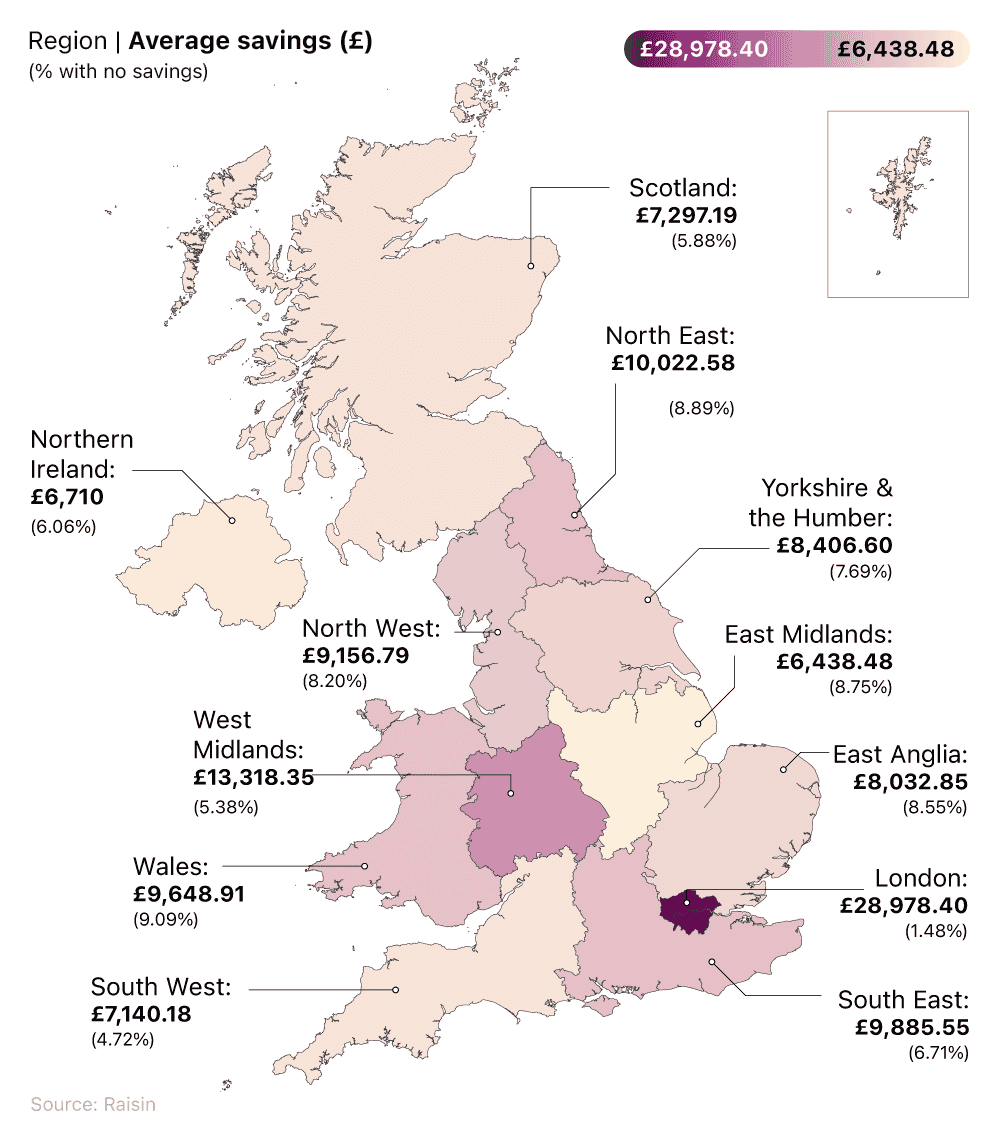
Only two other regions of the UK record average savings over £10,000, the North East with £10,023, and the West Midlands with £13,318. The location of these regions indicates that there is no strict trend between geographical position and average savings.
Although residents of the North East have the third-highest average savings amount, the region records the second-highest proportion of residents with no savings, at 8.89%. This puts the region only 0.2% behind Wales, whose residents are most likely to be without a cash pot (9.09%) across the UK.
Average UK savings by age
As is to be expected, average savings increase in line with age, with those aged 55 and over recording an average of £20,028.60. That means the near-retired and already retired have savings worth 707.23% more than those of the youngest adults (18-24-year-olds, with £2,481.16).
Average UK savings by age group
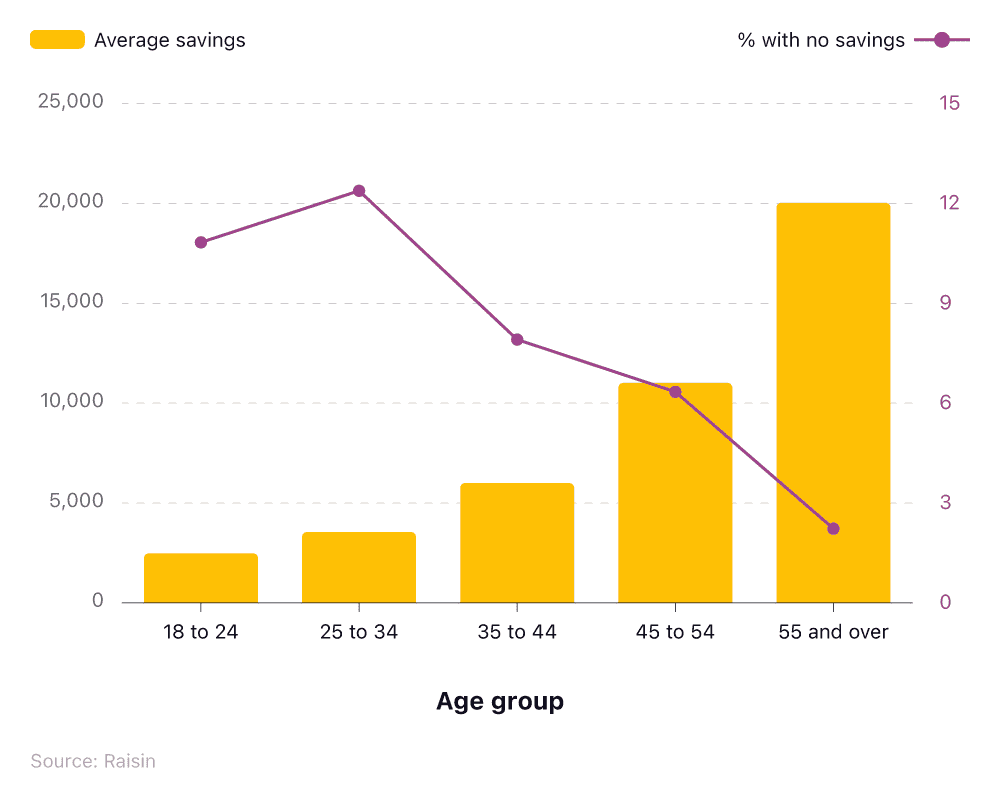
Although data indicates savings increase as you get older, the proportion of adults without savings does not directly correlate with age. Those aged 25-34 are the most likely to report having no savings (12.38%), a figure over 1.5 percentage points higher than that of the younger age group of 18-24-year-olds.
Average UK savings by gender
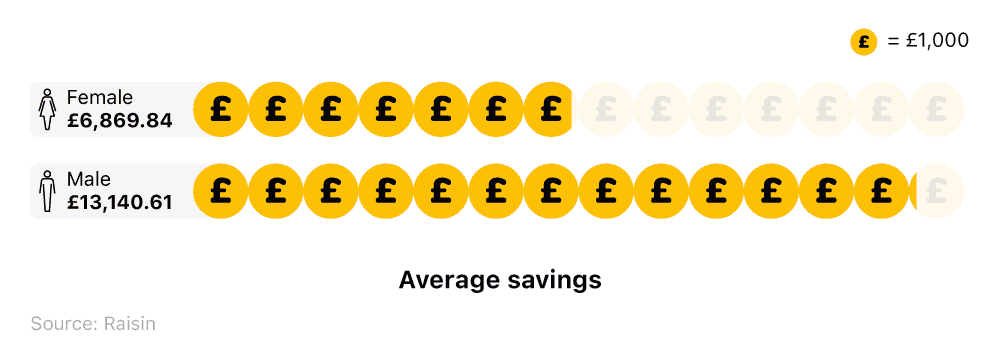
Data indicates there is a significant gender savings gap. While men typically have average savings of £13,141, women are reported to only have a cash pot of £6,870, on average. This means women are 47.72% worse off than their male counterparts.
Average UK household savings
Savings facts from the ONS show that, as of Q4 2024, the average UK household saved 12% of its income. This ratio is the proportion of the household’s disposable income - including labour and non-labour income and net transfers (such as pensions received) - that is not used for consumption.
The figures for the average UK household savings statistics reflect the unpredictable nature of the economy, wages, and the cost of living over the last decade. After a high point of 27.5% in Q2 2020, the savings ratio began to fall steadily over the following few years. This peak is likely a result of decreased non-essential expenses due to the COVID-19 lockdown, meaning households were saving more than usual.
The lowest point of the slump occurred in Q2 2022 when the household savings ratio sank to 4.5%. While this figure came as part of a wider downward trend, the particularly low percentage may be down to the economic instability of the cost-of-living crisis.
Average UK household savings by quarter
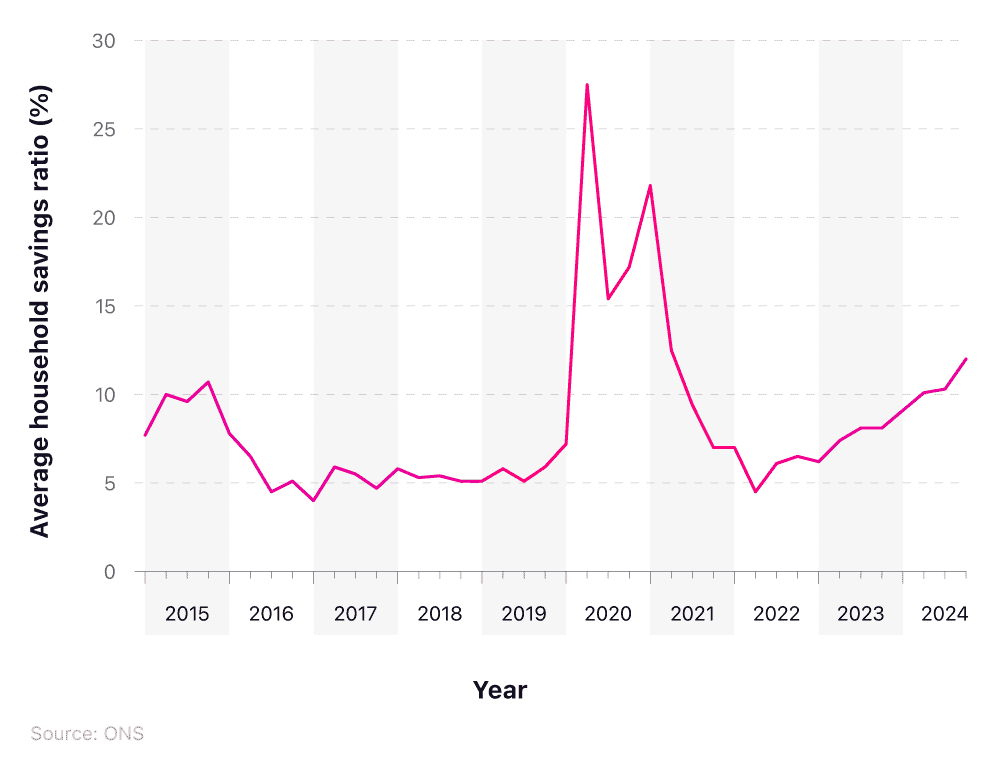
Since the trough in Q2 2022, the savings ratio of UK households has largely been on the rise, except for two quarters. In Q1 2023, the ratio of savings made by houses dropped slightly, from 6.5% in the previous quarter to 6.2%. Meanwhile, between Q3 and Q4 2023, the ratio plateaued at 8.1%.
The Q4 2024 figure of 12% is the first time the savings ratio has been at 12% or above since Q2 2021, when it stood at 12.5%.
Average UK wealth statistics
The ONS measures household wealth as disposable income after direct taxes, including income from employment, investments, and cash benefits.
UK average household wealth
Annual data on average household wealth in the UK shows a continuous level of fluctuation since 2014/15. Over this ten-year period, the average household disposable income within the UK has risen and fallen between around £42,400 and £45,300.
UK mean household disposable income by year
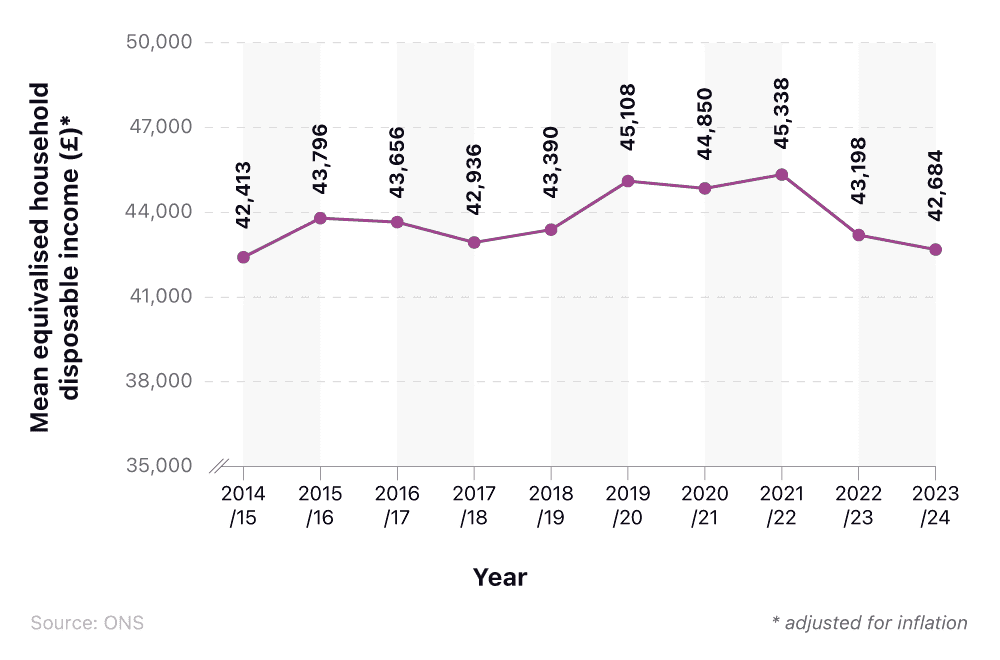
The latest figures from 2023/24 reveal that UK households have an average disposable income level of nearly £42,700, representing a decrease of 1.19% from the previous year (£43,198).
The biggest monetary increase would occur between 2018/19 and 2019/20, when household disposable income increased by 3.96%, or £1,718, from £43,390 to £45,108.
Average wealth by age UK
With a mean wealth of nearly £49,200, people aged between 55 and 64 have the highest average wealth by age in the UK as of 2023/24. The data shows that average wealth then decreases as you age, to a point of £31,113 for those aged 85 and over.
Inflation-adjusted mean disposable income across different age groups in the UK
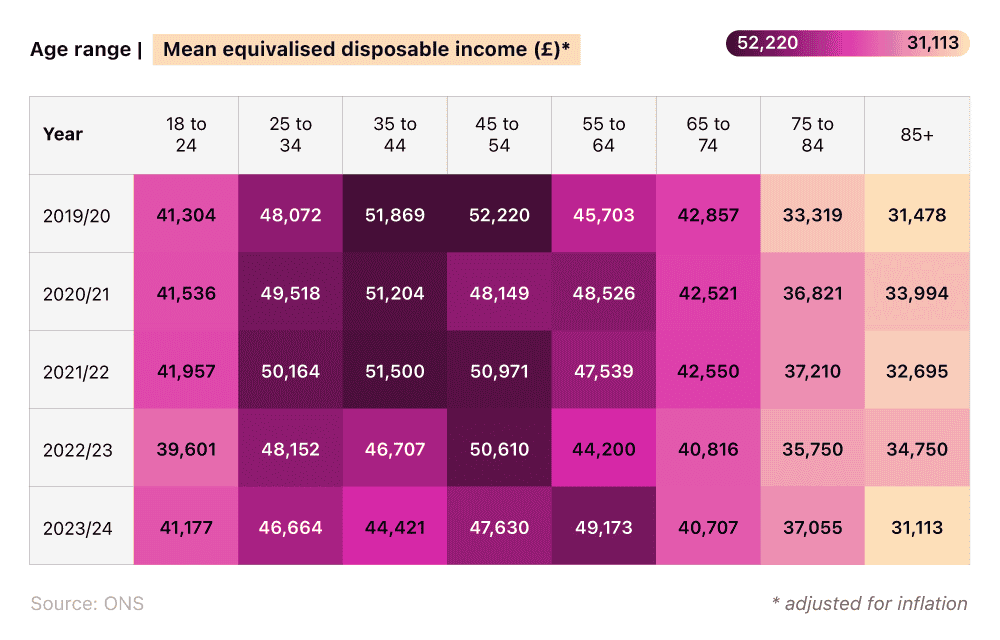
The biggest percentage increase can be found between the age groups 18-24 and 25-34, where the average wealth almost rises by 13.33%, from £41,177 to £46,664.
Since 2019/20, the highest average wealth was seen in the 45-54 age group in 2019/20, when those in this age bracket recorded an average wealth of £52,220.
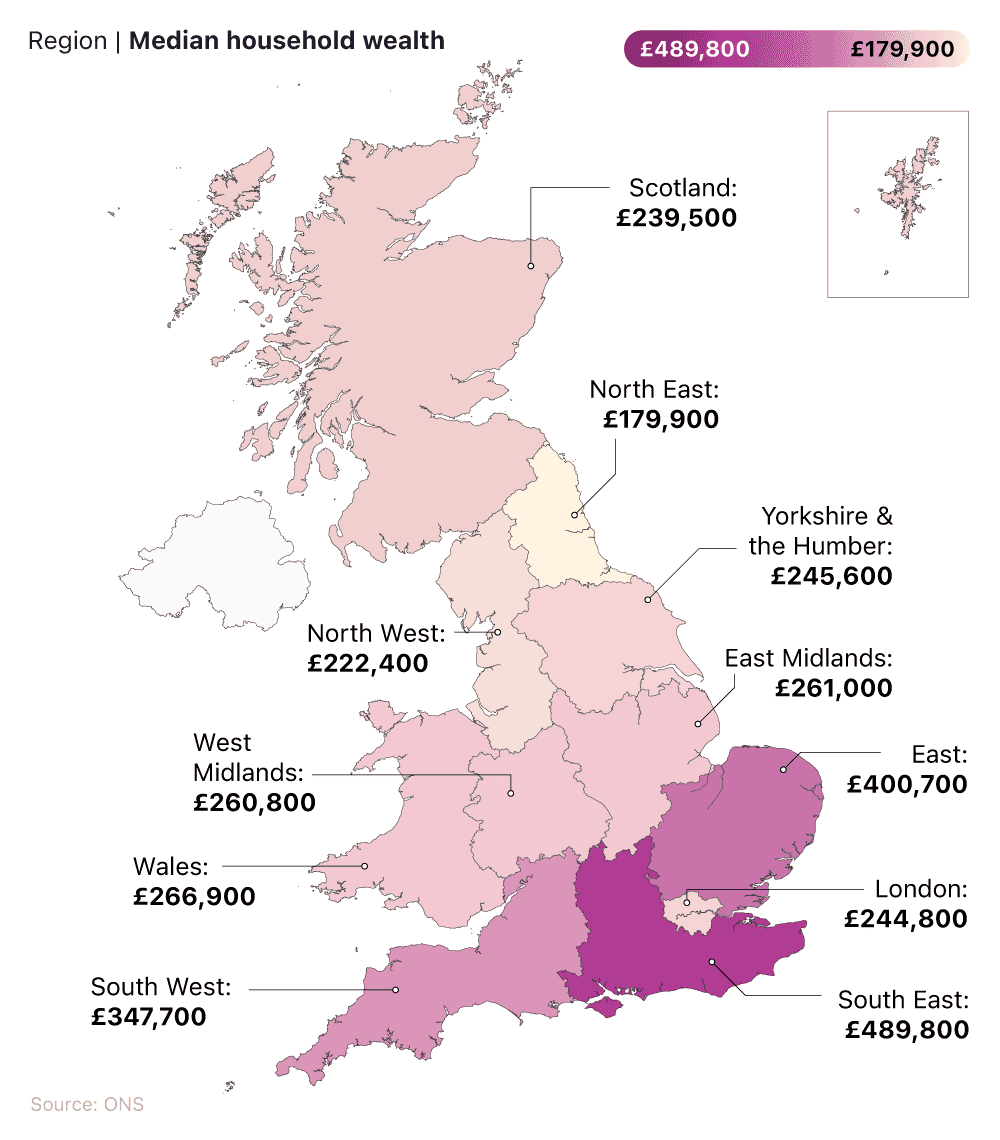
UK student savings statistics
According to student savings stats from the 2024 Student Money Survey, over four-fifths (81%) of students worry about making ends meet, with three-fifths (60%) stating that their mental health suffers as a result of these worries.
Nearly half (46%) of the students surveyed stated that, in an emergency, they would need to turn to their overdraft to secure funds, while narrowly fewer (45%) students would dip into their savings.
Average UK student monthly spending

According to recent student savings statistics, the average student spent £1,104 per month on outgoings in 2024 – a 2.41% increase on the previous year.
Rent accounts for nearly half (48.91%) of a student’s monthly living costs, followed by groceries (13.04%), and energy bills (6.88%).
Over one in six (17%) students are paying off interest monthly, with the average amount per student sat at £19 per month.
Save the Student estimates that maintenance loans (a government-funded loan designed to cover everyday living costs) typically fall short by £504 – nearly the average amount spent by students on rent - leaving them no money to afford other expenses. This is confirmed by nearly three-fifths (58%) of students who stated their maintenance loan was not enough to live off of.
Average savings in UK student savings accounts
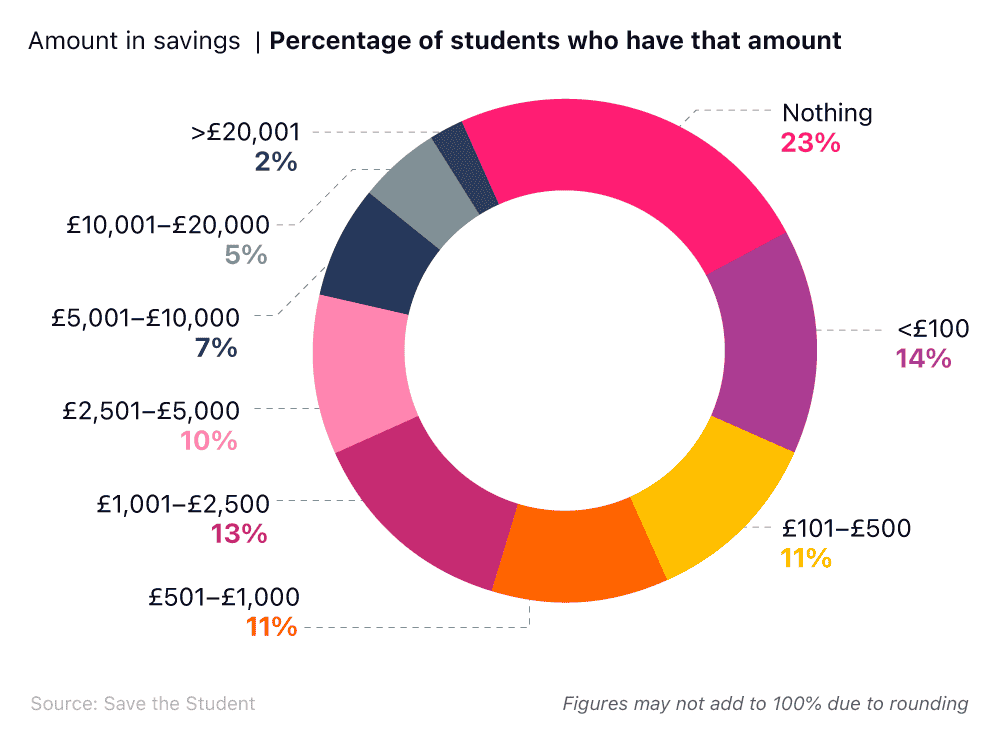
The average amount of money that UK students had in their savings in 2023 was £655. However, the most popular response recorded in the survey was that the respondent had no savings. Nearly a quarter (23%) of students have no money in savings, a change from the most popular response of £1,001 to £2,500 recorded by 16% of respondents in the previous edition of the survey. Moreover, the proportion of students with no savings is up from 14% in the previous year.
A further 14% of students had less than £100 in savings, while £101-500 and £501-1,000 were the amounts selected by around one in 10 students each (11%).
Factors affecting savings in the UK
UK interest rates statistics
The best place to save your money is more complex than just picking the savings account with the highest rate of interest. Despite this, the rate of interest you get on your money will likely be a deciding factor.
In November 2022, the Bank of England increased the benchmark base rate from 2.25% to 3% -the eighth consecutive hike since December 2021, and the highest for 14 years. This also happened to be the biggest single increase in the base rate since 1989.
In recent years, the Bank of England’s base rate has climbed steadily, reaching a peak of 5.25% in August 2023 – marking the highest level seen in over 14 years. However, since mid-2024, the Bank of England has gradually reduced the base rate, first to 4.25% in May 2025, and then to 4% in August 2025
With interest rates falling, some may question: is having a savings account worth it? While lower base rates reduce mortgage costs, they also mean that banks and building societies have begun to ease savings rates. ISAs can still offer some competitive savings rates though.
The main benefit of an ISA is that you can earn interest tax-free. If someone with an average salary (around £37,430 a year) saved 8.3% of their income, and put it in an average instant-access savings account for 12 months, they would receive £139.84 in gross interest over twelve months, assuming they haven’t exceeded their £1,000 personal savings allowance. If they were to put their money into a tax-free cash ISA, they would net £147.54 in interest. In a 2023 survey by the BSA, over a third (34%) of people surveyed admitted they never checked what interest rate they were getting with their bank or building society.
If you’re looking to play the long game, you may wish to choose a Lifetime ISA, earning you 25% on savings up to £4,000 a year. Or you may like to choose a fixed-bond savings account, which ties your money up for a set term, during which you agree not to make a withdrawal. A savings bond normally requires that you invest a set sum of money (usually a minimum of £100, but sometimes up to £5,000) in return for a fixed rate of interest over a set period.
Alternatively, if you’re after a more flexible savings account, you may opt for a notice savings account, which has common notice periods ranging from seven to 30 days, extending up to 120 days.
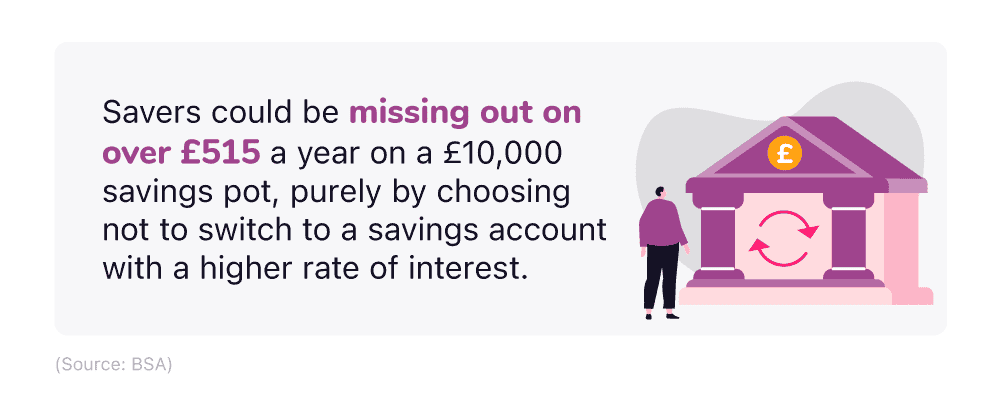
Studies have also found that hoarding cash at home can be bad for your financial health, therefore, the best place for your money is in a savings account. Savers can now get 4% or more on a savings account, while still maintaining access to their money.
UK savings market trends highlight that throughout 12 months, savers could be missing out on over £515 per year on a £10,000 savings pot purely by choosing not to switch to a savings account with a higher rate of interest.
Triple pension lock
Under the UK’s pension triple lock 2025, the State Pension is due to increase each year in line with inflation, average increase in UK wages, or by 2.5% (whichever is the highest).
How the triple pension lock is calculated
| Financial year-end | Factor | Based on: |
|---|---|---|
| April 2019 | 2.60% | Earnings growth |
| April 2020 | 3.90% | Earnings growth |
| April 2021 | 2.50% | 2.5% minimum |
| April 2022 | 3.10% | Consumer Price Index inflation |
| April 2023 | 10.10% | Consumer Price Index inflation |
(Source: Department for Work and Pensions)
The triple pension lock was introduced in 2010 by the Conservative/Liberal Democrat coalition government, and comes into effect each April.
The triple lock pension aims to ensure the value of the state pension isn’t overtaken by the increased cost-of-living, or the working population’s income. It protects only the full, basic State Pension of £176.45 per week, and the full, new State Pension of £230.25.
As the triple pension lock index rises each year by the highest of the three indicated factors, it becomes more generous than each of the individual components, which compounds over time.
For the 2025/26 financial year, the state pension increased by 4.1%, in line with the average earnings growth measure - higher than both inflation and the 2.5% minimum. These amounts are:
Approximately 10% higher than if the pension had been indexed to CPI inflation alone since 2011/12.
Roughly 10% higher than if it had been linked solely to average earnings over the same period.
Around 3% higher than if it had followed a ‘double lock’ system, increasing in line with either inflation or earnings, but without the 2.5% minimum increase. Nearly 13 million people received a state pension in August 2024 (approximately 19.2% of the UK population and an increase of 1.6% on the year prior), which accounted for around 55% of all social security expenditure in Great Britain.
In the 2023/24 financial year, this equated to approximately £124 billion, an increase of around £7 billion compared to the previous year. According to the Department for Work and Pensions (DWP) estimates:
Expenditure would have been £9.8 billion (or 7.9%) lower had pensions been uprated in line with earnings alone since 2011/12.
Further, it would have been £10 billion (or 8%) lower had the triple lock been replaced with CPI-based increases over the same period.
The DWP forecasts that, in 2025/26, the government will spend £174.9 billion in benefits for pensioners in Great Britain.
Those above retirement age with no other source of income can also claim pension credit, which increased by 4.1% in April 2025. As of August 2024, 1.4 million people received pension credit, although this doesn’t include those who are eligible and didn’t claim it.
Regardless of the financial pressures caused by rising living costs, almost two-thirds (64%) of those with no savings claimed they could probably save at least £10 a month.
With so many people relying on their savings as a source of income, finding the best savings account has never been so important.
FAQs
What is Annual Percentage Yield?
Annual Percentage Yield (APY) is the effective annual rate of return that takes into account the effect of compounding interest. Unlike the simple interest rate, APY gives a more accurate picture of how much you’ll earn or owe over a year, as it accounts for the frequency with which interest is added to the balance.
What is the role of the Bank of England?
The Bank of England (BoE) is the central bank of the United Kingdom. Its primary roles include setting interest rates to control inflation, issuing currency, overseeing other banks, and working to maintain overall monetary stability within the UK. Through these actions, the BoE plays a crucial role in promoting economic well-being and financial security.
How does compound interest work?
Compound interest is when you earn money not just on the amount you originally put in, but also on the money that you've already earned from that original amount.
What is the consumer price index?
The Consumer Price Index (CPI) is a measure that examines the average price of a basket of consumer goods and services purchased by households. It’s a significant indicator of inflation, as it shows the change in the cost of living over time. When the CPI rises, it indicates a period of inflation, and when it falls, it signifies a period of deflation.
What is an emergency fund?
An Emergency Fund is a savings account that is used to set aside funds to cover unexpected expenses or financial emergencies. This could include house maintenance issues, car repairs, or an unexpected job loss. Having an emergency fund provides financial security and peace of mind as it allows individuals to cover unexpected expenses without having to rely on credit or loans. For more insight into savings accounts, visit our UK savings account statistics page.
Methodology and sources
https://www.ons.gov.uk/economy/grossdomesticproductgdp/timeseries/dgd8/ukea
https://www.lendingstream.co.uk/blog/uk-money-saving-habits/
https://www.savethestudent.org/money/surveys/student-money-survey-2022-results.html
https://www.savethestudent.org/money/surveys/student-money-survey-2023-results.html
https://www.ons.gov.uk/economy/inflationandpriceindices/timeseries/l55o/mm23
https://www.bbc.co.uk/news/business-63641414
https://www.bbc.co.uk/news/business-57764601
https://www.bbc.co.uk/news/business-63218331
https://commonslibrary.parliament.uk/research-briefings/cbp-7812/
https://www.bbc.co.uk/news/business-53082530
https://commonslibrary.parliament.uk/research-briefings/cbp-7812/
https://www.money.co.uk/savings-accounts
https://www.money.co.uk/savings-accounts/instant-access-savings/results
https://www.bankofengland.co.uk/statistics/visual-summaries/effective-interest-rates
https://www.ons.gov.uk/economy/governmentpublicsectorandtaxes/publicsectorfinance/articles/how
About Lucinda O'Brien
Lucinda is a senior finance editor at money.co.uk and helps people to make confident financial decisions so they can make the most of their money.
